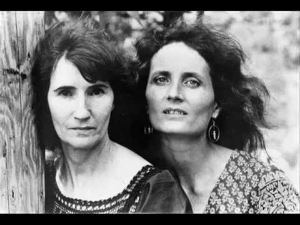I'm making a playlist of all Hasil Adkins, Hazel Dickens and Little Jimmy Dickens, because why not?
In my bluegrass harmony singing class this week (taught by Michael Daves and Jen Larson, a pair whose expertise and ease with the music inspires and astounds me, and who joined me in the studio recently to master Jen's knockout of an EP), we learned the Hazel and Alice version of the Bill Monroe song "The One I Love Is Gone." As I was leaving the studio to go to class, I hurriedly put the song on my iPhone so I could learn it en route. I listened to it on repeat the entire train ride to Brooklyn. I could not tear my ears away. As Jen said in class, it's the "torchiest" of bluegrass duets, and the Hazel and Alice version is knife sharp. Ordinarily, I am a modest singer, and I like to sing modest songs, nothing showy, not too much love, not too much heartbreak. But I tell you, I have been belting this song at home.
Now I'm on a mission to find out how many of Hazel and Alice's recordings are still in print, and if they are out of print.... maybe someone needs to track them down, send them to me, and we can get them back into this world.
Incidentally, my introduction to Little Jimmy Dickens came via my 93 year old grandfather, born and raised in West Virginia, who told me his mom used to tell him to "take an old cold tater and wait." Had to google that one, but it led me right to Jimmy. I doubt grandpa listened to much Hasil Adkins, but who knows? They were fellow West Virginians.



 The highlight of my whirlwind trip to Seattle for the Experience Music Project Pop Conference was not an early morning run around Lake Union, past dewy purple wildflowers and toddling goslings in perfect 55 degree weather. But that was pretty freakin nice.
The
The highlight of my whirlwind trip to Seattle for the Experience Music Project Pop Conference was not an early morning run around Lake Union, past dewy purple wildflowers and toddling goslings in perfect 55 degree weather. But that was pretty freakin nice.
The 